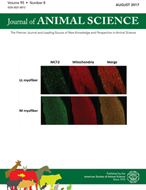-
Views
-
Cite
Cite
O. Adeola, B. V. Lawrence, A. L. Sutton, T. R. Cline, Phytase-induced changes in mineral utilization in zinc-supplemented diets for pigs, Journal of Animal Science, Volume 73, Issue 11, November 1995, Pages 3384–3391, https://doi.org/10.2527/1995.73113384x
Close - Share Icon Share
Abstract
Forty-eight pigs (barrows:gilts, 1:1) with an average initial weight of 9.4 kg were used in a 2 × 2 factorial experiment to determine the influence of dietary phytase (0 or 1,500 phytase units/kg) and zinc (0 or 100 mg/kg) supplementation of a cornsoybean meal diet on the utilization of P, Ca, Cu, Mg, Mn, and Zn. After a 21-d growth experiment, feed was withheld for 24 h and blood was collected from the anterior vena cava of all pigs for plasma mineral analyses. Twenty-four barrows from the growth experiment were then placed in metabolism cages and used in an 8-d mineral balance study. All pigs were maintained on their previous diet. Growth rate was fastest (P < .05) and feed efficiency was highest (P < .05) for pigs fed phytase-supplemented diets. Feed intake was unaffected (P > .05) by dietary treatment. Plasma P (P < .01) and Mg (P < .05) concentrations increased with phytase addition. Plasma Zn concentration increased (P < .05) when phytase was added to the diet containing no supplemental Zn, but plasma Zn concentration was not affected (P > .05) by phytase when the diet was supplemented with 100 mg of Zn/kg. Apparent Ca, P, and Cu balance were improved (P < .05) with phytase addition; however, Cu balance was reduced (P < .05) by Zn supplementation. Zinc balance was increased (P < .05) with supplemental zinc and phytase in the diet. These results indicate that the growth-promoting effect of phytase may be due to an overall increase in the availability of minerals.





